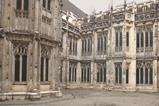Sarah Richardson’s final leader as editor of Building
Looking across a city skyline can be an experience threaded with nostalgia: the history of people and places told through buildings which have been shaped decades, even centuries, apart. The city of London – visible from Building’s offices on the South Bank – is one place that offers such a view. And writing this, looking out over that skyline, I have to admit to feeling a little more nostalgic than usual, as this will be my last leader as editor of Building, a magazine I joined as a reporter 13 years ago, and have had the privilege of editing for the last five.
It’s fair to say that when I joined Building, I had very little awareness of the construction industry – despite the best efforts of my dad, who spent his working life in the sector. But as a journalist who started out simply wanting to break stories, whatever the subject, I was quickly struck by the fascinating variety of projects and people in the sector. And also, by what ought to be understood much more widely outside the industry: the way in which the sector’s fortunes are intrinsically bound up with – and contribute to – wider economic, social and political changes.
From the fortunes of businesses that contribute almost 7% of GDP, to the go-ahead for Hinkley, to the cancellation of the government’s £55bn Building Schools for the Future scheme – the stories Building breaks hold significance not just within the sector, but beyond it too.
As a journalist who started out simply wanting to break stories, whatever the subject, I was quickly struck by the fascinating variety of projects and people in the sector
But the key reason the industry is deserving of greater understanding and recognition is the extent to which it can shape the outcome of some of today’s biggest economic and social challenges.
At a time when the Brexit vote has brought economic uncertainty to the UK, greater public investment and more targeted policy support for housing, education and infrastructure projects would, by giving certainty to a large sector prone to boom and bust, underpin greater economic stability. The fact that by doing so, the government could at a stroke speed up desperately needed work on the country’s outdated transport network and deteriorating schools, not to mention its woefully inadequate supply of homes, should not be an argument that the industry has to fight to get heard – notwithstanding government ministers’ current focus on urgent trips to Brussels.
But this isn’t just about numbers; the built environment shapes the world in which we live. It has an impact on everyone, and the direction taken by the construction industry, in general and on individual developments, will determine the nature of that impact.
Emerging understanding of the impact of buildings on wellbeing, coupled with greater access to building performance data for occupiers and individuals, offers the prospect of pioneering work being done in this area becoming mainstream, to the benefit of people’s emotional and physical health. Meanwhile, against the backdrop of a society still plagued by divisions, architects and construction firms have an opportunity – more than that, a responsibility – to create communities that bring people together, rather than driving them apart.
But this isn’t just about numbers; the built environment shapes the world in which we live - it has an impact on everyone
The industry today is, clearly, facing some huge challenges – not just from external economic factors, but also within itself. A legacy of underinvestment in skills has left the sector facing a decline in its labour force of up to 25% within a decade, and with female and non-white employees still a small minority, it’s no secret that the industry needs to appeal to a wider talent pool to attract the workers that it needs.
But progress has been made: the fact that Building’s cover interview today is with a female leader heading up an 18,000-strong business is testament to that. The tide is turning – but for businesses’ own sake, the efforts of the sector’s leading employers still need to be replicated more widely.
At the same time, the push towards greater digitisation and off-site, pre-manufactured techniques, offers a key to a more productive industry that cannot be allowed to fall victim to cost pressures on initial outlay. Clients, and in particular government clients, have a central role to play in ensuring this does not happen, and it is in their interests to do so, given the cost and time savings that have already been shown to come with both developments.
Looking back at that skyline, I hope that these techniques will help shape a valued next generation of places. And there is every reason to believe they will, because behind the buildings, there is an industry full of talent, determination, and – still – some unforgettable characters. I hope to cross paths with many of you again in the future, but for now, I wish you every success.

Follow Sarah on Twitter @SarahR100View full Profile




























No comments yet